Reading Gun Tests means having a front-row seat to watch the evolution of firearms. But it’s rare that so much change is represented within a single roster. In this test we’ll compare three bolt-action rifles with what we call traditional, modern, and progressive designs. Even with its Kryptek camouflage coating and heavy barrel, the $1000 Howa 1500 from Legacy Sports International filled the traditional role with a standard-profile stock, bolt, trigger, and safety. The newest version of the $1252 Savage Model 12 LRP series was aptly named because it mirrors the modern long range precision rifle. The $1399 Ruger Precision Rifle progresses the idea of a precision military or competition rifle built around the ergonomics of the AR-15 rifle in mass production for a mass-production price.
What ties these rifles together is the 6.5 Creedmoor chambering, which was named — if not designed for — the famed Creedmoor Cup rifle competition. The Creedmoor Cup is a three-day event consisting of 16 different matches with a total of 240 shots fired standing, seated, and prone at distances of 200 yards, 300 yards, and 600 yards. The essence of the 6.5 Creedmoor round is a 6.5mm (0.264-inch diameter) bullet launched with approximately the same velocity and relatively flat trajectory of the 300 Winchester Magnum, but with considerably less recoil. This is important because, unlike hunters, competitive shooters need to be able to withstand the recoil of hundreds of rounds during matches and practice.
Not every maker is currently producing 6.5 Creedmoor, but based solely on available choices, Hornady Manufacturing is the most prolific. Our test rounds were Hornady’s 129-grain SST Superformance hunting load, plus Hornady’s 140-gain A-Max, and 120-grain A-Max Match rounds. We also tried handloading equivalent ammunition consisting of once-fired Hornady brass and 140-grain Hornady A-Max bullets to learn more about the cartridge. However we were limited in overall cartridge length to suit the detachable magazines of the Ruger Precision Rifle.
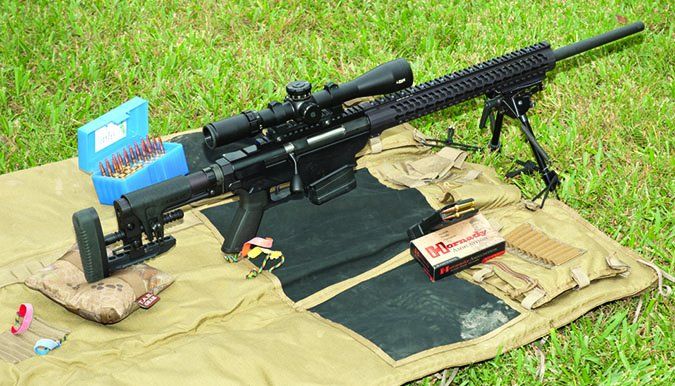
The Howa arrived with its own scope in place and with camouflage finish to match, but to put each gun on equal footing at the range, we shot our test rounds with Bushnell’s new 2.5-18×44 Long Range Hunting Scope featuring 30mm tube construction, 0.25-MOA click value, and the innovative 62M reticle. Bushnell’s Tactical Hunter series scopes feature first-focal-plane magnification, which means you can keep the reticle lines small to block only a minimum amount of target. Accuracy data was collected by shooting 5-shot groups from the 100-yard bench at Houston’s American Shooting Centers (amshootcenters.com). We are aware that the 3-shot group is being used as the standard elsewhere, including within the rules of Ruger’s Precision Rifle challenge, but we like the 5-shot standard better because it says more about heat management and how the shooter is helped or hindered throughout the rigors of multiple shots. Here’s how the rifles performed for our shooters:
Howa Hogue Kryptek Cerakote Package HKF92507KH+AB 6.5 Creedmoor, $1000
This is the list price. We found the package retailing for $795 at RichiesPNG.com, but it was also out of stock. You can find a retailer on the Legacy Sports website under Contact > USA Dealers.
Based on the company’s 1500 action, the Howa rifle was the most straightforward in terms of profile, offering a Sporter-style Hogue Overmolded stock with an aluminum bedding block. It was treated to a Kryptek Highlander camouflage coating, as was the Nikko Stirling 4-16x44mm GameKing scope included in this package. The barreled action was sheathed in Austrian Brown Cerakote and free-floated, connecting to the stock with two pillars fore and aft of the trigger guard and the hinged floorplate of the magazine. The Howa rifle felt quite rigid, and the surface of the stock was friendly to the hands and cheek. A beefy rubber buttpad was mounted, and there were sling swivels front and rear. The forend of the stock was broad enough to make good contact with a sandbag or any other surface. The No. 6-profile heavy barrel was 24 inches long. The result was a heavyweight hunting rifle (9.5 pounds loaded) with a commanding presence.
We couldn’t help but notice that Ruger’s Marksman adjustable trigger looks and acts very much like Savage’s AccuTrigger, each with a hinged lever integrated with the trigger face. Howa’s two-stage HACT (Howa Actuator Controlled Trigger) looked common in comparison, but is renowned in its own right. The Howa HACT trigger offered a short take up to a soft, but predictable, break. Measured using a Lyman digital scale, weight of resistance averaged just under 2.6 pounds, with a maximum deviation of no more than 6 ounces. At no time did anyone on our team find the fluctuation so obvious that it affected accuracy or the shooting experience in general. One member of our team thought the trigger was further to the rear than they liked.
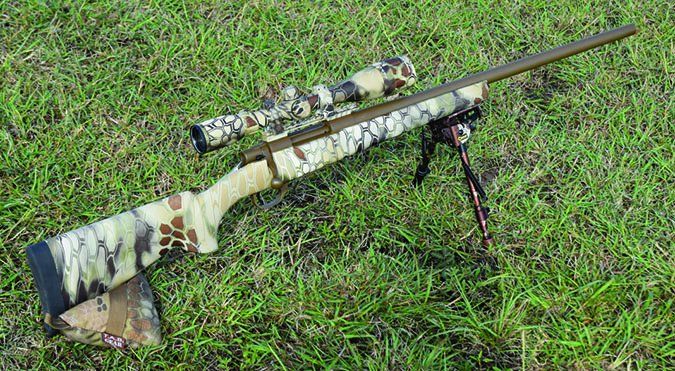
The bolt action featured very positive ejection early in the rearward stroke. Clamping down the bolt handle required a little extra strength, signifying a tight lockup. Both the three-position safety and bolt-release levers were sheet metal to hold down costs. While not aesthetically pleasing, they were more likely to bend than break, and both levers worked without flaw.
At the range, we began shooting with the 4-16x44mm Nikko Stirling scope that came mounted and bore sighted on a spacious Picatinny rail as part of the package. On the 18th round downrange, something came loose in the scope and appeared in the sight picture. We were able to continue without ill effect, and whatever it was eventually disappeared from view. But for the remainder of our tests, we switched to the Bushnell 4.5-18×44 LRHS scope and continued to use the Bushnell for the Ruger and Savage rifles as well, thus ensuring a level playing field for each rifle.
Results showed that a rifle does not have to be tactical or sniper-fancy to deliver accuracy. While the best average we could compile firing the Superformance rounds measured about 1.1 inches across, efforts shooting the 120-grain A-Max Match ammunition resulted in 5-shot groups ranging from about 0.6 inches to 0.9 inches. Switching to the Bushnell scope, we were able to place the 140-grain A-Max rounds into groups about 0.5 to 0.9 inches wide.
Our Team Said: The camouflage and Cerakote package was a very appealing upgrade and helps this rifle compete with the pizazz of the latest “tacticool” stocks and chassis. The importer (Legacy Sports International) will soon offer an upgrade to a 10-round detachable box magazine for even more flair. This could limit cartridge length for handloaders daring to increase their rounds’ overall length in search of greater accuracy. But shooting a half-minute of angle out of the box is difficult to argue with.
Savage Arms Model 12 Long Range Precision (LRP) 19137 6.5 Creedmoor, $1252
The next movie about a military sniper may feature a rifle similar in construction to the Ruger Precision Rifle, but based on the accuracy and simplicity of the Long Range Precision Rifle Model 12, the specially bedded fiberglass stock is still the heavyweight champion, even if this platform is under attack from the chassis designs. The HS Precision Pro Series Tactical (PST) stock on the Savage grabs your attention, as do the LRP’s 1-inch-diameter 26-inch-long fluted carbon-steel barrel, oversized bolt handle, and scrolled and polished chrome bolt.
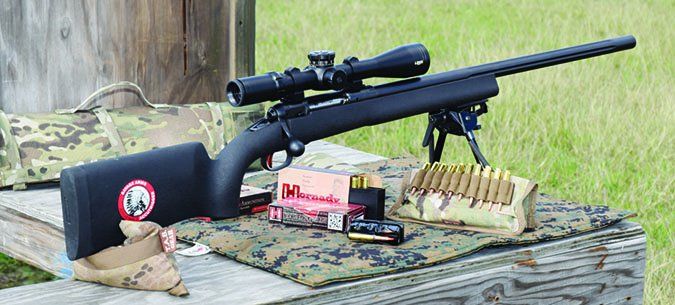
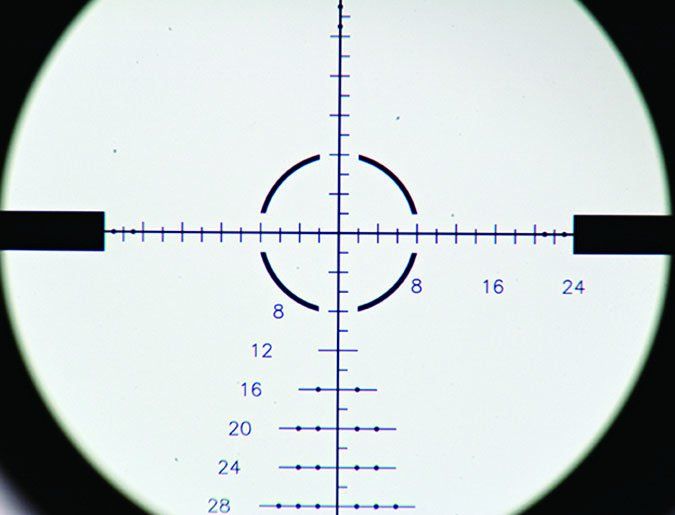
Our test rifle model, No. 19137, was so new at the time of this writing that the manufacturer had not yet assigned a photograph to its web link. But it does resemble the $3695 HS Precision PLR custom rifle, though our test rifle offered a more vertical grip and the barrel of our LRP showed decidedly less taper. The heft of the barrel walls made the 6.5mm bore look relatively tiny, with the result being a rifle that was heavy but with a balance point very near the center of its 46-inch-plus overall length.
The Model 12 fed from a detachable magazine. We liked that it fit flush to the receiver, but magazine capacity was limited to only three rounds. Formed from sheet metal, the magazine’s construction was robust. While feeding and working the action, we found it to be smooth and reliable, but also a bit heavy, in our view. The words, “Warning: Precision Target Trigger” were emblazoned on the left side of the action, and, yes, this was indeed a special iteration of Savage’s Accu-Trigger. The center activation lever was also colored red to remind the shooter to pay extra attention. Our Savage LRP had the lightest-weight trigger in our test, coming in at about 2.25 pounds with little variation. The trigger sensation was very easy to learn, and it did not ask the shooter to overcome a sharp break or wait through a lengthy compression.
The tang-mounted safety offered a third central position so the bolt could be worked with the trigger locked down. We found ourselves more willing to use the safety on this rifle (rather than just leave the bolt open) because the stock was so comfortable in the hand. Both sides of the vertical pistol grip offered the same natural palm swell, leaving the thumb for either left-handed or right-handed shooters resting atop the safety. So far, index to the trigger was about perfect for everyone who has shot the LRP.
Some of our smaller shooters thought the buttstock felt a little long, but length of pull measured only about 13.5 inches. We think its length was somewhat of an illusion caused by the supplied two-piece scope base. With only one cross slot fore and aft of the ejection port, adjustment for eye relief was limited to sliding the scope back and forth within the rings.
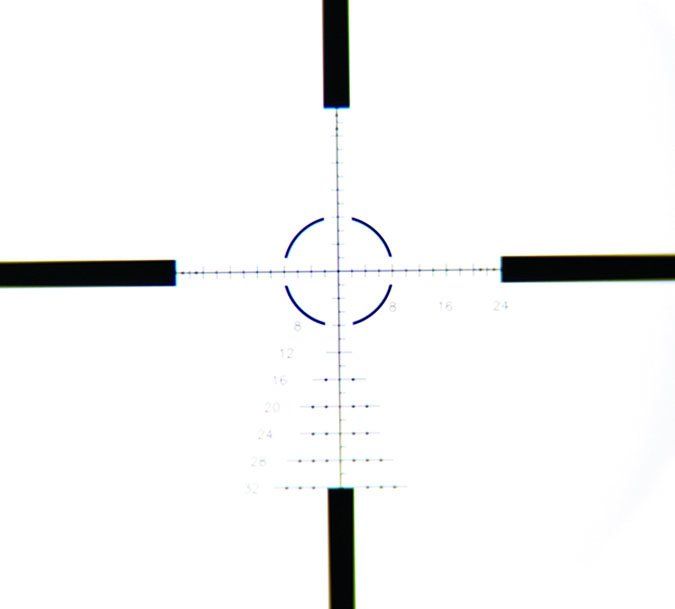
In testing the Howa and Ruger rifles, we saw a distinct preference for the A-Max Match loads and much less willingness for those rifles to deliver the 129-grain SST Superformance hunting loads into a tight group. Before shooting the Savage, we credited this to the Superformance ammunition being designed more for terminal ballistics than match-grade accuracy. But the Savage was ready to pile at least one shot on top of another in every group, including those shot with the Superformance. In addition, both A-Max rounds produced some sub-half-inch groups. The Howa and Ruger rifles each favored the Hornady 140-grain A-Max ammunition with an average-sized group of about 0.6 inches. The Savage tied this performance and delivered 5-shot groups averaging 0.6 inches and 0.5 inches across for the 129-grain and 120-grain ammunition, respectively.
Our Team Said: Our wish list for the newest Savage Arms model 12 LRP was very short: A one-piece scope base, a second sling stud beneath the forend, and maybe an adjustable cheekpiece. In the meantime, buyers of this rifle are going to be bored shooting at less than 300 or 400 yards. If longer-range competitive shooting interests you, this rifle is probably the simplest and least expensive way to get started.
Ruger Precision Rifle 18005 6.5 Creedmoor, $1399
ChampionFirearms.com listed this rifle for $950, but the retailer wasn’t accepting pre-orders for the gun. SlickGuns.com had it on sale for $1200, but it was out of stock. Kentucky Gun Co. (KYGunCo.com) was likewise out of stock, with a retail price of $1080 and a cash price of $1049. Sportsmans Supply auctioned one on GunBroker.com, with the bid up to $1501 when we checked it last.
First reactions to the Ruger Precision Rifle ranged from “It’s a bolt-action AR” to the expectation that the RPR was a “chassis” rifle. Actually, nether is correct, but the RPR draws from both of these platforms. A chassis rifle consists of a frame, including a buttstock, folding or rigid, and support structure for the barreled action, trigger mechanism, and magazine well connected to a forend that may or may not be skeletonized, but provides bore-centric rails for mounting optics, laser aiming devices, or illumination. A true chassis rifle, such as those made by Accuracy International, JPRifles or Ashbury Precision Ordnance, provides a complete structure into which a barreled action is bolted in place. If the RPR were a true chassis rifle, then maybe the barreled action from one of Ruger’s three Hawkeye bolt-action rifles chambered for 6.5 Creedmoor would fall right into place. But the Ruger Precision Rifle is more of a hybrid design built around Ruger’s patented American-style action and the company’s SR AR-15/type rifles.
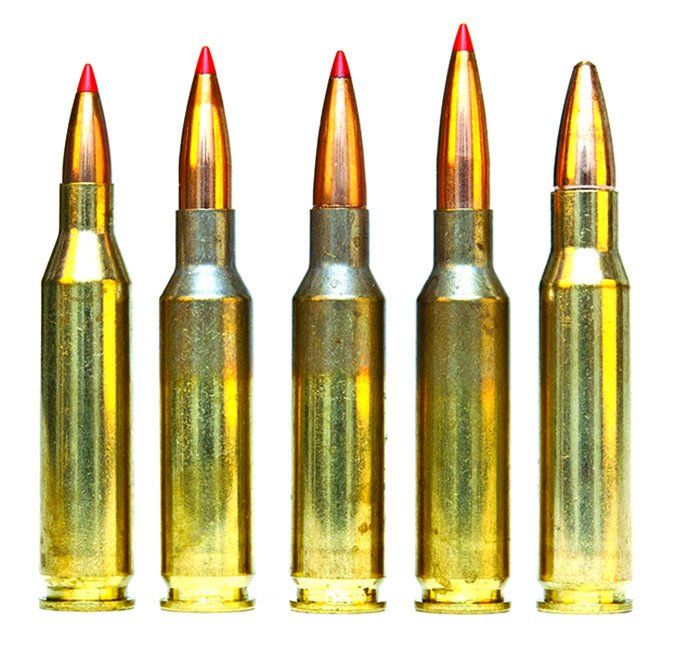
Nonetheless, the RPR takes advantage of the many AR-like features that the American public has fallen in love with. The 15-inch-long Samson key-mod free-float handguard is ready to accept Picatinny rails in just about any position the operator desires. The top rail was affixed at 12 o’clock and extended the 7.8-inch-long Picatinny rail directly above the receiver. Bore-to-rail height was very close, and recoil was designed to move straight to the rear at the top of the 0.9-inch-thick rubber buttpad. The buttpad was designed to be adjustable for cant, but we found the primary locking screw to be frozen and were unable to move it from its vertical set. Adjustment for length of pull was much easier via a cam and clamping lever. With the release lever pulled away from the rifle, the buttpad could be moved closer to or further from the receiver by rotating the large threaded shaft. Despite variations in size, each staff member was able to adjust for eye relief and comfortable extension of the arms and wrists.
The cheekpiece that covered what looked very much like an AR-15 buffer tube was also held by a cam and clamp, but the cheekpiece simply slid up or down on a spring-loaded race. Hand-setting the position was a little tricky, requiring the operator to pinch the lower forks of the cheekpiece to release it from its spring-loaded detent.
Sporter-rifle stocks offer a pistol grip, but when compared to the AR-15 that would be in name only. The true pistol grip found on the RPR was interchangeable with just about any available AR-15 grip. The AR-15/style thumb safety was limited to movement between 9 o’clock on-Safe and about 11 o’clock to Fire, because unlike the AR-15, its family tree does not include full-auto operation. The safety lever can be moved to the right-hand side, if so desired.
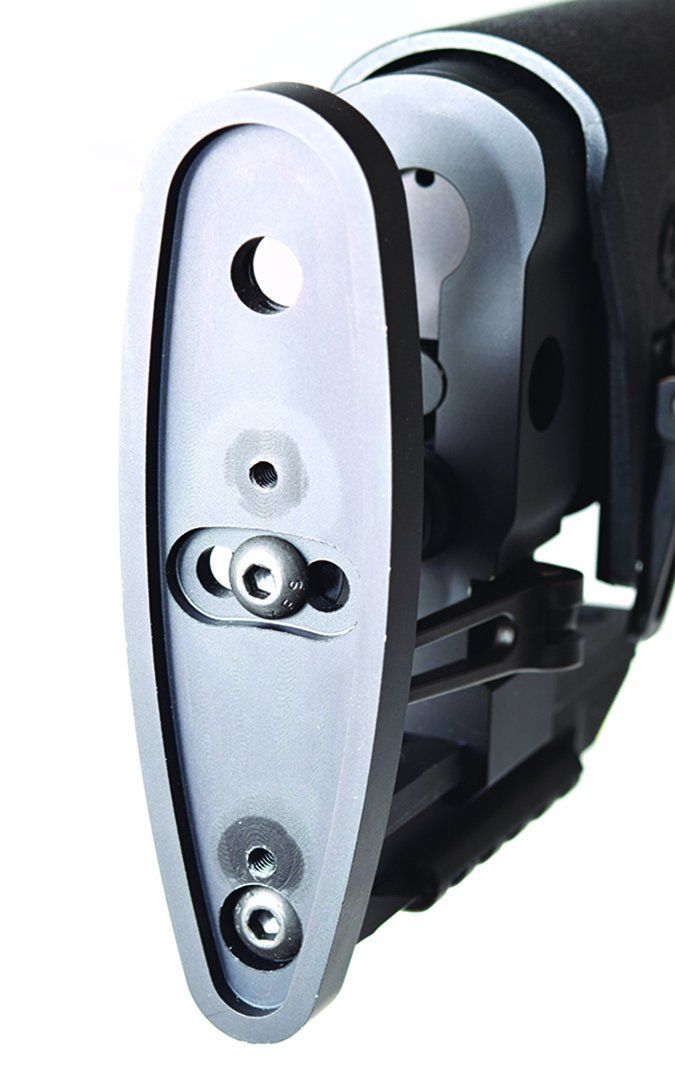
The RPR was very long, thanks to its 24-inch barrel and a long bolt assembly. The barrel was threaded and those threads were capped, but the thread cap was difficult to remove. We chose not to force it off, especially in the absence of a barrel vise. Adding a suppressor to the threaded barrel would make it a real fishing pole. The folding stock helped shorten the rifle for transport, but unless you’ve got a properly padded case, we think most people will carry the RPR extended, partially because the stock does not lock down when folded.
Removing the bolt required folding the stock, pulling up the bolt handle, and pressing the release lever located on the left-hand side of the receiver. The rear of the bolt was sealed with a polymer cap bearing the Ruger logo, so it is protected and does offer a finished look. The cap screws off and reveals a compartment holding a 5/64th-inch hex wrench to disassemble the bolt or adjust the trigger. Trigger pull upon arrival measured 2.55 pounds, with a maximum variation observed as being only about 1.4 ounces. This was light enough and consistent enough, in our view.
The magazine release consisted of a vertical lever at the rear of the magazine well. Patented by Ruger, we found it to be very easy to grasp the magazine and activate the release lever with either hand. Two ten-round polymer magazines (PMags by Magpul) were supplied, but those made by AICS will also work. Provisions for a QD (quick detachable) sling mount consisted of the female portions of the system only. The QD mounts were found on the left side of the buttstock, but they could be moved to the opposite side. The forward QD attachment was held via the key mod system, so it could be moved to anywhere along the handguard. A 3.75-inch-long Picatinny rail with sling stud was supplied. A shooter could use the stud to mount a bipod. A Picatinny rail measuring about 2.25 inches long was machined into the lower structure of the buttstock. This rail could be used to connect a monopod or to provide a flat surface for rear bag support.
When firing the Ruger off sandbags, we found that the profile of the forend wasn’t as stable on bags as it was with a Harris bipod we tried after gathering accuracy data. We tried a lot of positions on the sandbags, including pushing the rifle forward into the bags so that it was braced against the magazine and magazine well. Also, bolt travel was not as smooth as we would have liked, but the trigger was very consistent, and it was smooth enough to let the shooter concentrate on other things, such as breathing and taking aim. The only feature our shooters really didn’t like was the cheekpiece. Its top radius followed the arc of the tube below, but was then squared off at about 9 o’clock. As shooting progressed, every member of our team sooner or later felt the edge rubbing uncomfortably into the face.
In terms of accuracy, the Ruger Precision Rifle was very consistent. One group fired with the 129-grain Superformance ammunition measured 1 MOA exactly, with a final average of 0.9 inches. The 120-grain A-Max rounds provided an average group of 0.7 inches, while the 140-grain A-Max rounds printed 0.6-inch-wide 5-round groups one after another.
Our Team Said: If America votes with their dollars, then the AR-15 is the most popular rifle in the land. This bodes well for a bolt action designed in its image, with many of the same ergonomics and popular features. What we liked most about the Ruger Precision Rifle’s performance was that except for a lack of comfort at the cheekpiece, it really lets shooter perform at a high level. No matter what the size or body type of our shooters, the results were very much the same. In the case of the 140-grain ammunition (handloaded or factory), we found it remarkably easy to print 5-shot groups into 0.6-inch groups one after another.
Written and photographed by Roger Eckstine using evaluations from Gun Tests team testers.

























